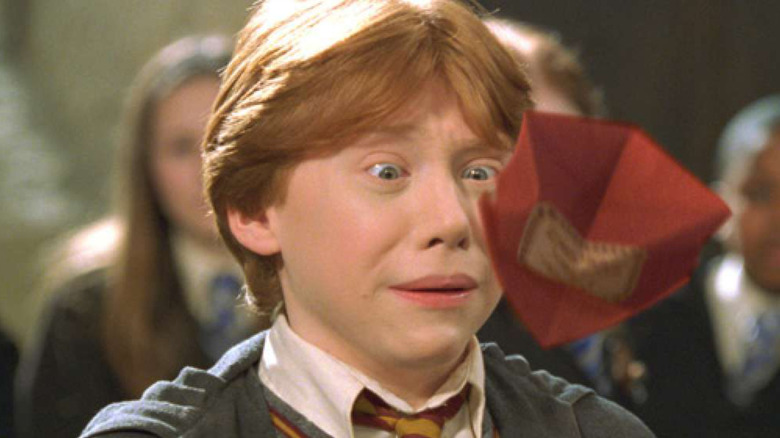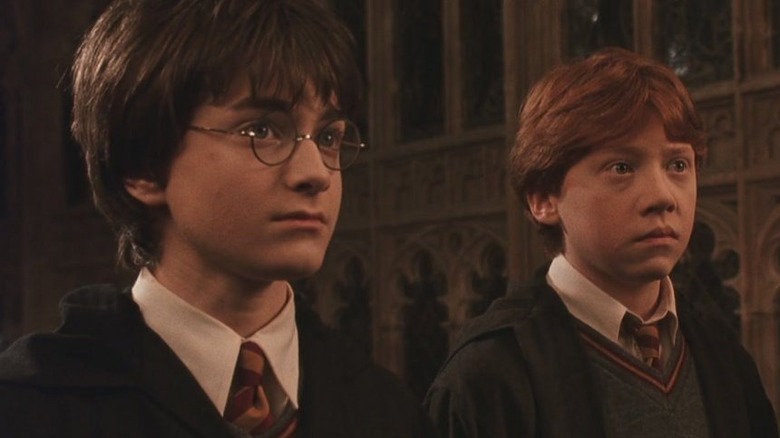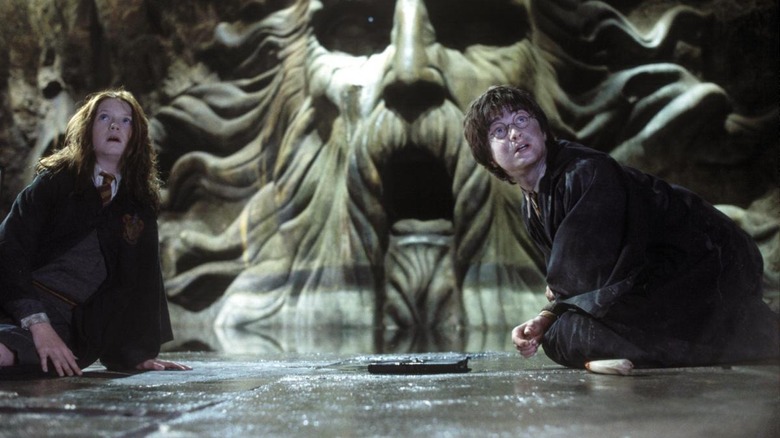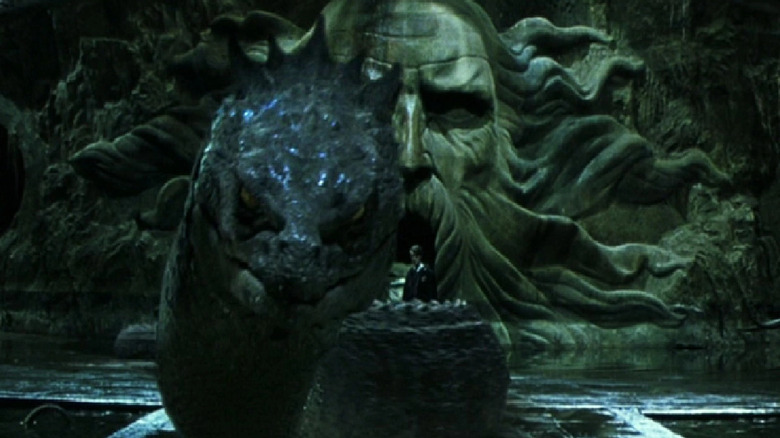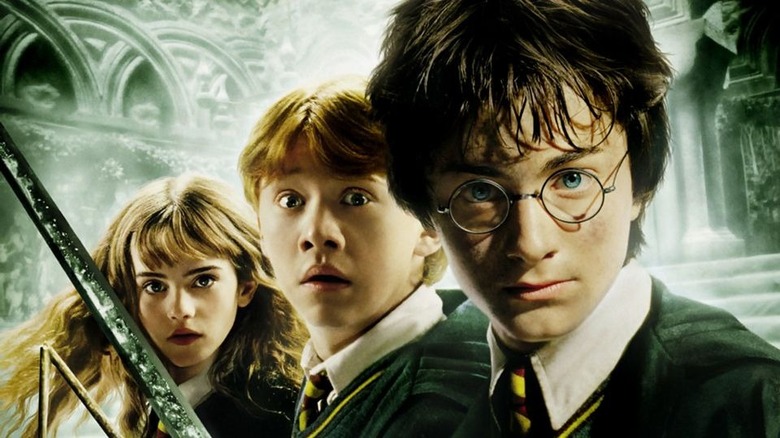The Ending Of Harry Potter And The Chamber Of Secrets Explained
One of the amazing things about the "Harry Potter" series is how the films mature in tone and style along with its flowering trio of teenage protagonists. In comparison to later entries, early films like "Sorcerer's Stone" and "Chamber of Secrets" are much more lighthearted. The younger actors, paired with the livelier cinematography and boisterous score, made for something more akin to a story for kids and adolescents. Of course, this changes quite rapidly as Harry and his friends mature into young adults embroiled in a harrowing war against history's deadliest magician.
Despite the more adolescent mood of the first two films, it's quite surprising how much "Chamber of Secrets" expands on the "Harry Potter" universe to make room for the more teen- and adult-oriented stories that would follow. The history of Hogwarts is deepened by the Chamber's existence, and the second entry in the series reveals the first glimpses of Voldemort's troubled backstory. All of this culminates in the ending of "Chamber of Secrets," which sets up a multitude of plot devices used by later films.
Harry saves himself a lot of trouble by accidentally destroying a horcrux
The most significant example of how the ending of "Chamber of Secrets" sets up films to come is with Voldemort's (aka Tom Riddle's) schooltime journal. Though neither viewers nor Harry knows it at the time, the journal in question is something very important indeed. Obviously, it's an important relic from the main antagonist's past, but it's not until "Order of the Phoenix," five movies later, that viewers understand that the journal is a Horcrux.
Unbeknownst to Harry, he has conveniently destroyed one of the several objects enchanted by Voldemort to stave off his mortality. Destroying the Horcruxes is the only way to truly stop Voldemort from returning, so Harry saves himself quite a bit of trouble just by being a meddlesome twerp, lucky him. That being said, Horcruxes aren't the only future plot elements touched upon with the journal at the end of "Chamber of Secrets."
Viewers are introduced to Tom Riddle
Voldemort's tragic backstory is one of the most critical plot lines that run through the later "Harry Potter" films. "Half-Blood Prince" and the entries that follow it delve more deeply into the life and times of Tom Riddle, but "Chamber of Secrets" gives fans their first taste of the sadistic young wizard who would become Voldemort. While not quite as reptilian as he would appear in other films, the comparatively plain teenage Riddle takes the role of antagonist just to prove to audiences that he's always been a bad egg.
Author J.K. Rowling would later expand on this youthful predilection toward evil by characterizing Riddle as somewhat tragic. Later films reveal that he was an orphan born out of a fragile bond between a wizard and a muggle catalyzed by a love potion. Because he was conceived from a relationship built of magical love drugs, Voldemort was born incapable of comprehending the emotion. His depiction in "Chamber of the Secrets" stays true to this later revelation as Riddle tries his utmost to kill non-pure-bloods through the Basilisk.
The Chamber of Secrets reveals new layers to Hogwarts' history
Speaking of the Basilisk and other horrors of the Chamber, "Chamber of Secrets" also deepens the history of Hogwarts by introducing new elements related to its founders. While "Sorcerer's Stone" only familiarized audiences with the founders through the school's different Houses, "Chamber of Secrets" introduces its eponymous location and the Sword of Gryffindor, and it gives viewers an idea of just how long this pure-blood vs muggle-mixed divide has plagued the wizarding world.
Hogwarts is centuries old, yet the schism between pure-blood wizards and the rest of the magical community runs deep even there. Hogwarts co-founder Salazar Slytherin constructed the Chamber for the specific purpose of housing the Basilisk and giving his heir (Voldemort) a method of dispatching those "lesser" students that weren't 100% pure-blooded.
Meanwhile, the opposing ideology of Hogwarts' history is represented by the Sorting Hat, the Sword of Gryffindor, and the appearance of Fawkes in the final hour. For as long as Slytherin has been scheming against Hogwarts' more inclusive student body, Godrick Gryffindor has been fighting to embolden it.
The Sword of Gryffindor vindicates Harry's heroic character
Fawkes' rescue, along with the sudden, last-minute appearance of the Sorting Hat and Sword are seemingly minor events in the grand scheme of things. But they're incredibly important within the context of "Chamber of Secrets" itself. Throughout this film, Harry stands as a possible suspect in the search for Slytherin's heir. After he speaks Parseltongue to a snake in front of his class, many students assume Harry is the one responsible for reopening the Chamber and attacking other students. Even Hermione admits that it's possible for Harry to be related to Salazar Slytherin, thus qualifying as his heir (via Harry Potter Wiki).
Still, Harry has proven his courage and good nature before, and he manages to do so again in the film's conclusion. The appearance of the Sword and Hat, which only come to those deemed true Gryffindors, cements Harry as a hero even as others doubt his true intentions. Harry's connection to Voldemort, and therefore Slytherin, aren't inherent within him, but they do give him a window into Voldemort's psyche. In entering the Chamber of Secrets, successfully summoning the Sword, and using it to fight off the Basilisk, Harry vindicates himself as a hero.
